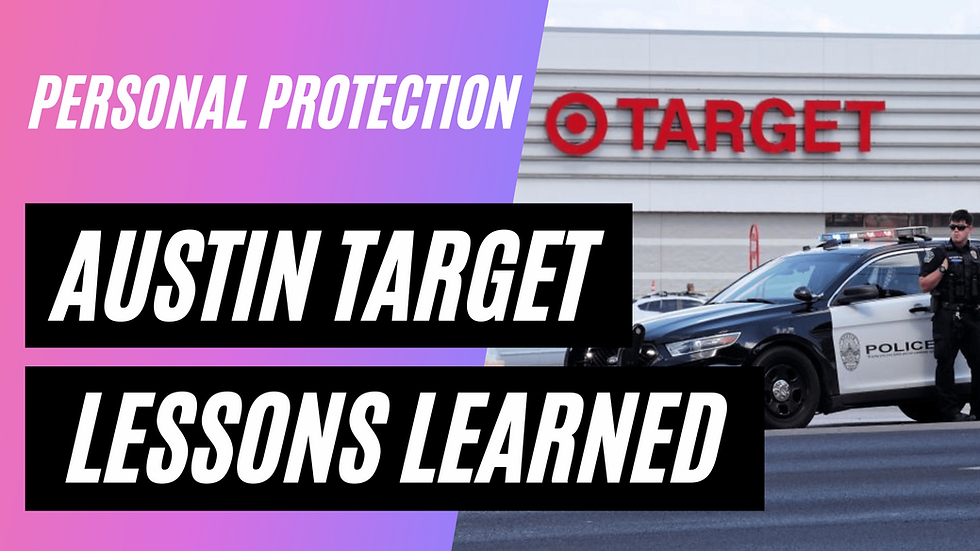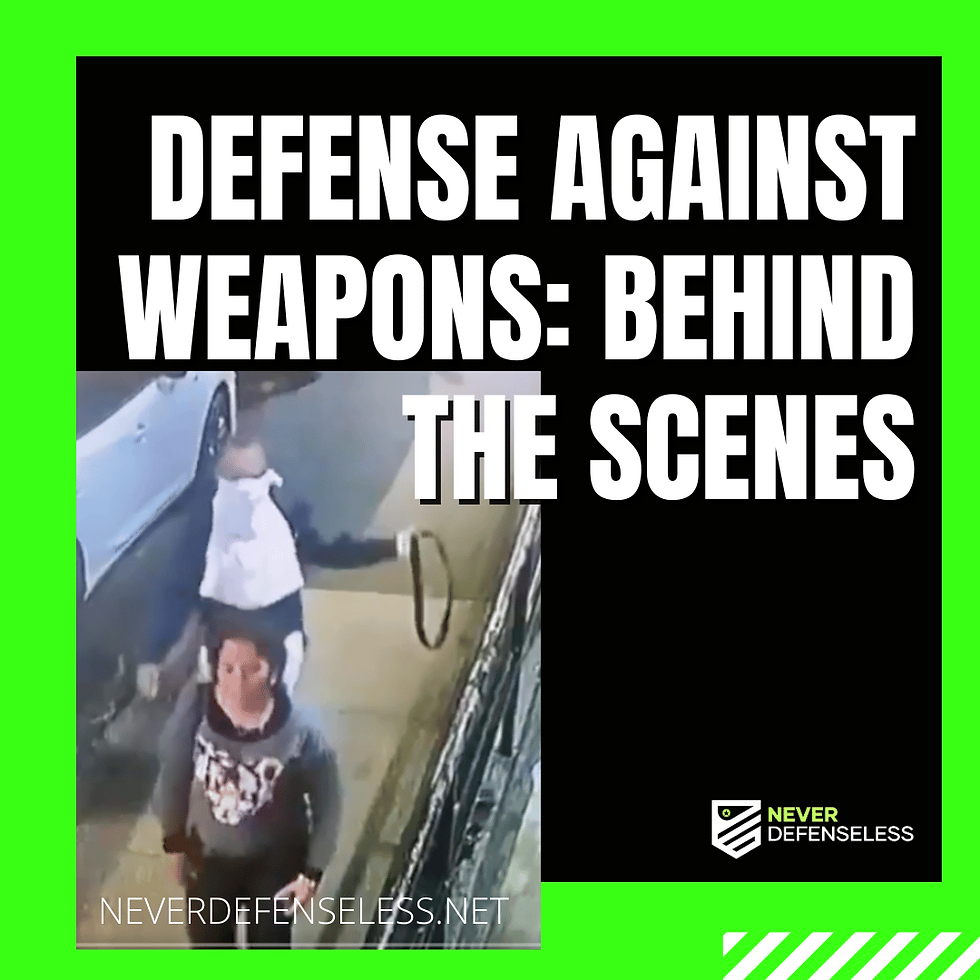Personal Protection: Why Women Can’t Afford to Outsource Safety
- WSDC

- Aug 20
- 5 min read

On August 11, 2025, tragedy struck in the parking lot of a Target store in Austin, Texas. A violent attacker with a long history of crime opened fire, killing three people, including a grandfather and his 4-year-old granddaughter. His wife was assaulted, their car stolen, and chaos continued until police apprehended him.
For women and families everywhere, this horrific incident is a sobering reminder that danger can appear without warning—and no company, store policy, or police response can guarantee your personal protection in the moment of crisis.
Personal protection begins with personal responsibility. Using the Austin tragedy as a case study, this article examines the limitations of municipal and corporate policies and emphasizes the critical role of preparedness, training, and mindset in self-defense.
A Failure of Wishful Thinking for Personal Protection
The suspect had a well-documented history of criminal behavior, including charges for domestic violence, driving while intoxicated, violating protective orders, and reportedly violent assaults on others – including a case of attempted strangulation. Despite this, he was not in custody and carried out what police described as a “random” and “unprovoked” attack. The victims—a store employee collecting carts, a grandfather, and his young granddaughter—had no warning and no means to defend themselves. This tragedy highlights a critical point: violent criminals do not adhere to societal norms, laws, or corporate policies.
Target’s official stance on firearms is clear: while acknowledging local laws regarding carry policies, the company “respectfully requests that guests not bring firearms to Target, even in communities where it’s permitted.” The stated goal is to “create an atmosphere of family-friendly shopping that’s safe and inviting for our guests and team members.” Yet, as the Austin shooting demonstrates, should we expect this policy to protect the victims?
The murderer, armed and unrestrained by Target’s request, clearly disregarded the company’s vision of a “safe and inviting” environment.
Now to be somewhat fair about this, Target’s policy is a “request” and armed citizens can be asked to leave the store – however, the company’s history with anti-gun groups like Moms for Action sets the public expectation. I’ll also note that this violent incident took place in the parking lot, not inside the store. Does a retailer have less control or less of an obligation to protect customers in the parking lot?
In reality, no. Businesses have a legal duty of care to maintain a reasonably safe environment for customers, who are considered invitees on their property. This duty requires taking reasonable steps to prevent harm, especially when there is a foreseeable risk of criminal activity. A business owner is typically not liable for spontaneous crimes, but they can be held responsible if they knew or should have known about prior criminal activity on their premises and failed to implement adequate security measures like surveillance cameras, better lighting, or security personnel. However, the more frequent the past criminal activity, the greater the duty to provide security.
Just two weeks prior, a Walmart in Traverse City, Michigan, was the scene of a violent attack where a man stabbed 11 people and was only stopped by the intervention of an armed citizen.
These events, occurring in places typically considered “safe”, remind us that violence can strike anywhere, at any time. Corporate policies that prioritize an idealized image over practical security measures often leave customers and employees vulnerable.
The System’s Shortcomings: You Are Your First Line of Defense
The Austin tragedy exposes a broader issue: the systems in place—both public and private—have proven to fail to protect individuals from violent crime.
While law enforcement responded quickly in Austin, arriving within four minutes of the 2:15 p.m. call, it was too late for the victims. Police cannot be everywhere, and corporate policies like Target’s offer no tangible protection against a determined attacker.
Yet, those citizens who take proactive steps to protect themselves often face criticism or lack of support from the same systems that fail to ensure their safety. Self-defense expert Jon Farnham aptly points out that when you decide to prioritize your personal security, you may encounter “an ocean of non-support” from media and authorities who may advocate for policies that inadvertently favor criminals over law-abiding citizens. This reality places the burden of protection squarely on us as individuals.
Taking Control: The Pillars of Personal Protection
While you cannot control when, where, or how a criminal will strike, you can control your preparedness.
We emphasize five key pillars of personal protection:
1 Life-Saving Equipment: Whether it’s a legally carried firearm, pepper spray, or other defensive tools, having the right equipment is essential. In states like Texas, where concealed carry is permitted, law-abiding citizens have the right to arm themselves for self-defense. However, policies like Target’s can create a false sense of security, discouraging responsible armed citizens from carrying in places where threats are real.
2 Training: Owning a firearm or defensive tool is only half the equation. Regular, high-quality training ensures you can use your equipment effectively under stress. Professional instruction builds your skills and builds confidence in high-pressure situations.
3 Skill Level: Proficiency comes from practice. Regular range time, scenario-based training, and physical fitness all contribute to your ability to respond effectively to a threat.
4 Awareness: Situational awareness is your first line of defense. By staying alert to your surroundings, you can detect potential threats early and avoid danger whenever possible. In the Austin case, the randomness of the attack underscores the importance of constant vigilance, even in seemingly safe environments like a retail parking lot.
5 Mindset: A self-defense mindset is about more than just tools or techniques—it’s about being mentally prepared to act decisively to protect yourself and your loved ones. It means accepting that threats exist and committing to your own safety, regardless of external policies or societal pressures.
Criminals control:
The time
The place
Number of attackers
Level of force they bring to their crimes.
By focusing on what you can control—equipment, training, skills, awareness, and mindset—you empower yourself to respond effectively when seconds count.
A Call to Action: Commit to Your Safety
The murders at the Austin Target store is a sobering reminder that safety cannot be outsourced.
Corporate policies, however well-intentioned, cannot stop a determined criminal. Law enforcement, while essential, often arrives after the damage is done. The responsibility for your safety—and that of your family or clients—rests with you.
We encourage you to take an active role in your personal protection. Evaluate your current preparedness:
• Do you have the right equipment?
• Are you trained to use it effectively?
• Is your situational awareness sharp?
• Do you have the mindset to act when it matters most?
These are not just questions—they are the foundation of a proactive approach to self-defense.
The Austin Target shooting is a tragic example of what happens when wishful thinking meets harsh reality. Target’s policy of requesting that customers not carry firearms did not prevent a violent criminal from taking three lives. Instead, it highlights the need for individuals to take responsibility for their own protection. By investing in the right equipment, training today to prioritize your self-defense—because no one else will do it for you. By building the skills, awareness, and mindset, you can reclaim control over your safety in a world where threats are unpredictable. Make the informed decision.
Sources:
• The New York Times, August 15, 2025
• KUT Radio, August 15, 2025
• AustinTexas.gov, August 12, 2025
• The Independent, August 12, 2025
• KUT Radio, August 14, 2025
• Newsweek, August 11, 2025
Note: This article is intended to inform and encourage responsible self-defense practices.




Comments